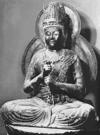- Vairocana
-
In Mahayana and tantric Buddhism, the supreme buddha who is the cosmic counterpart of Sakyamuni in his teaching mode.He is the most prominent of the five self-born buddhas, those who were born as humans to propagate the dharma. Though without canonical basis, Vairocana holds a special place in Tibetan Buddhism and has a special role in the Avatamsaka-sutra, in which he is the solar buddha who is both the ultimate reality of the cosmos and the one who pervades its component parts.
 Dainichi Nyorai ("Great Sun Buddha") by Unkei, lacquered wood sculpture, 1175; in the ...Asuka-en
Dainichi Nyorai ("Great Sun Buddha") by Unkei, lacquered wood sculpture, 1175; in the ...Asuka-en* * *
▪ Buddha(Sanskrit: “Illuminator”),also called Mahāvairocana(“Great Illuminator”), the supreme Buddha, as regarded by many Mahāyāna Buddhists of East Asia and of Tibet, Nepal, and Java.Some Buddhists regard Vairocana, or Mahāvairocana, as a being separate from the five “self-born” Dhyāni-Buddhas, one of whom is known as Vairocana (see Dhyāni-Buddha). Among the Shingon sect of Japan, he is the chief object of reverence and is regarded as the source of the entire universe. In Japanese he is called Dainichi Nyorai (“Great Sun Buddha”), or Roshana; in Chinese P'i-lu-che-na; in Tibetan Rnam-par-snang-mdzad, or Rnam-snang (“Maker of Brilliant Light”).When represented as one of the “self-born” Buddhas, as he is in Nepali, Tibetan, and Javanese art, Vairocana occupies the chief position and is often considered to be the progenitor of the other four Dhyāni-Buddhas, or the Ādi-Buddha himself. In paintings, Vairocana is coloured white and his hands are shown in the dharma-chakra-mudra (“teaching gesture”). His consort is Vajradhātvīśvarī or Tārā, his family Moha, his mount the dragon (or lion), his symbol the chakra (“wheel”), his skandha (“personality component”) rūpa (“matter”), his syllable a or om, his element space, his sense perception hearing, his sense organ the ear, and his location in the human body the head.In China and Japan, Vairocana is given reverence by Buddhists of the Yogācāra school (which led to the foundation of the Shingon sect). Legend claims that he transmitted to a supernatural personage, Vajrasattva, the Yoga doctrine, which was in turn introduced into China in AD 719 by Vajrabodhi and into Japan by Kūkei (Kōbō Daishi; 774–835).In Japan he is also worshiped in the form of the fierce Fudō Myō-ō (Chinese: Pu-tung-fo; Sanskrit: Acala), whose duty it is to combat evil and to take charge of the soul after death. Vairocana is frequently represented in Japanese painting and sculpture, most notably the 53-foot (16-metre), seated, bronze Roshana in the Tōdai-ji, at Nara, which was installed in AD 752 but restored in later centuries. As the supreme Buddha, his characteristic gesture is the mudra of the six elements, in which the index finger of the left hand is clasped by the five fingers of the right, symbolizing the uniting of the five elements of the material world (earth, water, fire, air, and ether) with the spiritual (consciousness).* * *
Universalium. 2010.
